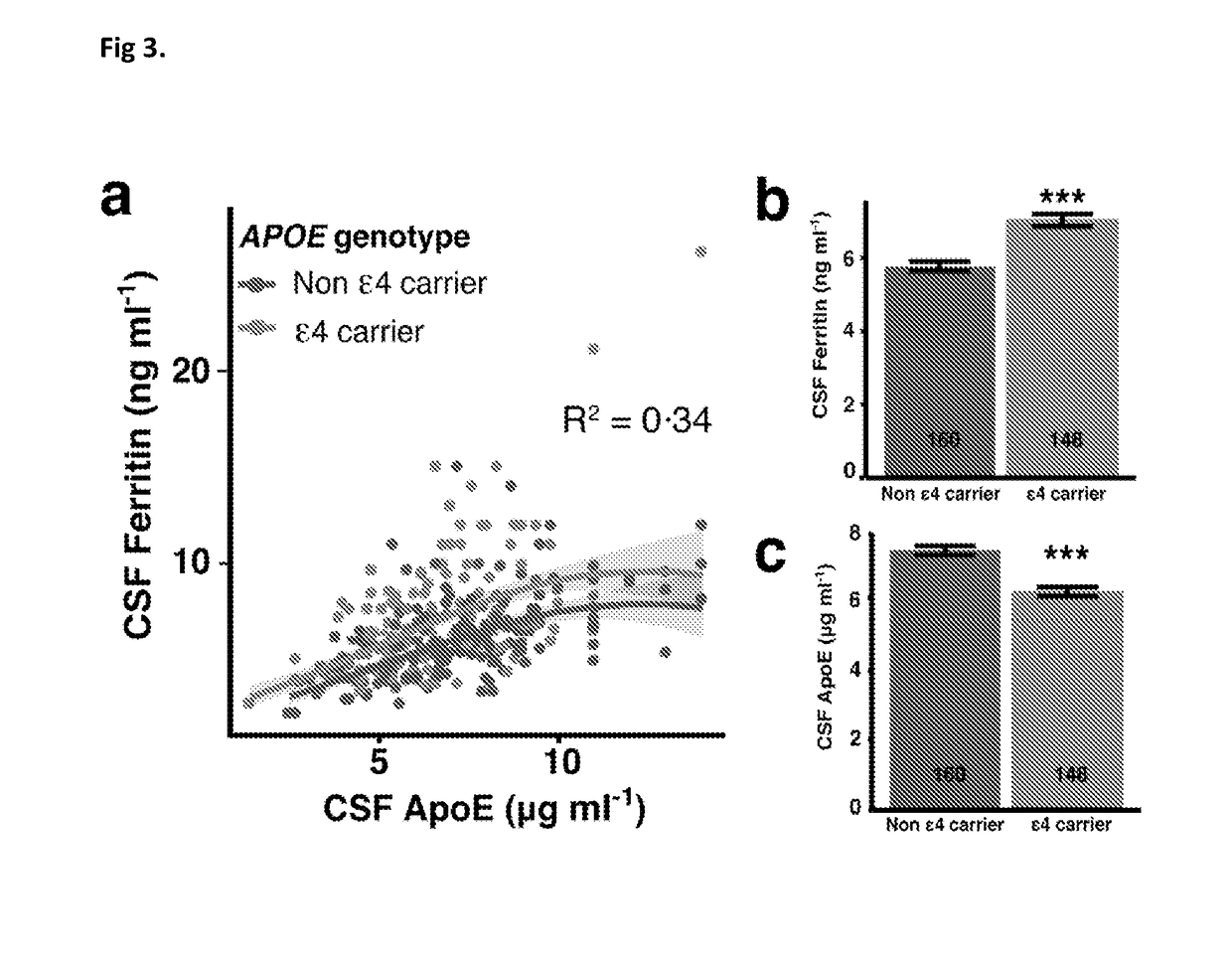Method for predicting risk of cognitive deterioration
a risk factor and cognitive technology, applied in the field of cognitive risk prediction, can solve the problems of no clinically acceptable prognostic biomarker for ad, no clinically acceptable ad prognostic biomarker, and already extensive burden of alzheimer's disease to australia, so as to measure cognitive deterioration
- Summary
- Abstract
- Description
- Claims
- Application Information
AI Technical Summary
Benefits of technology
Problems solved by technology
Method used
Image
Examples
example 1
Ferritin Levels in the Cerebrospinal Fluid Predict Alzheimer's Disease Outcomes and are Regulated by APOE
[0160]Ferritin is the major iron storage protein of the body; by using cerebrospinal fluid (CSF) levels of ferritin as an index, brain iron status impact on longitudinal outcomes was studied in the Alzheimer's Disease Neuroimaging Initiative (ADNI) cohort.
[0161]This example shows the association of baseline CSF-ferritin data with biomarker, cognitive, anatomical and diagnostic outcomes over 7 years in the Alzheimer's disease Neuroimaging Initiative (ADNI) prospective clinical cohort. It is shown that CSF ferritin levels have similar utility compared with more established AD CSF biomarkers, the tau / Ab1-42 ratio and apolipoprotein E (ApoE) levels, in predicting various outcomes of AD.
[0162](i) Methods
[0163]ADNI description. Data were downloaded on 15 Jul. 2014 from the Alzheimer's Disease Neuroimaging Initiative (ADNI) database (adni.loni.usc.edu). The ADNI study has been previousl...
example 2
Cerebrospinal Ferritin Determines the Risk of Cognitive Decline in Pre-Clinical APOE-E4 Carriers
[0197]The ε4 allele of apolipoprotein E (APOE) confers the greatest risk for Alzheimer's disease (AD), and recent data implicates brain-iron load as the risk vector since ε4 carriage elevates cerebrospinal (CSF) ferritin ≈20% (Ayton S et al (2015)). CSF ferritin levels predict longitudinal cognitive performance and the risk for Mild Cognitive Impairment (MCI) subjects transitioning to AD. This example shows that CSF ferritin combines with established AD risk variables, APOE-ε4, CSF tau / Aβ1-42 and ApoE, in predicting cognitive decline in normal people over 7 years.
[0198](i) Methods
[0199]This example used data obtained from the Alzheimer's Disease Neuroimaging Initiative (ADNI) database (adni.loni.usc.edu; 15 Jul. 2014).
[0200]Baseline CSF levels of Aβ1-42, tau (Luminex), ApoE, ferritin (Myriad Rules Based Medicine) and longitudinal Ray Auditory-Visual Learning Task (RAVLT; sensitive to earl...
example 3
Assessing a Risk of Cognitive Deterioration in a Patient
[0209]In conducting the methods of the present invention, it is contemplated that a patient will be assessed for a level of cognitive ability. This level will set a base for determining whether they will over time deteriorate. They patient may already show signs of cognitive impairment after being assessed.
[0210]A CSF sample may be obtained and the CSF ferritin level determined by methods such as immunoassay. This sample may then be compared to a predetermined sample from a CN patient processed in the same manner.
[0211]A difference in the CSF ferritin levels of the patient and that of the CN patient will be determined. Depending on the degree of difference, the degree of cognitive deterioration can be determined. If the difference is large and the CSF ferritin level of the patient is high relative to the CN patient level, the patient presenting for assessment may show a higher risk of cognitive deterioration. If the difference ...
PUM
| Property | Measurement | Unit |
|---|---|---|
| time | aaaaa | aaaaa |
| MRI | aaaaa | aaaaa |
| 3T MRI | aaaaa | aaaaa |
Abstract
Description
Claims
Application Information
 Login to View More
Login to View More - R&D
- Intellectual Property
- Life Sciences
- Materials
- Tech Scout
- Unparalleled Data Quality
- Higher Quality Content
- 60% Fewer Hallucinations
Browse by: Latest US Patents, China's latest patents, Technical Efficacy Thesaurus, Application Domain, Technology Topic, Popular Technical Reports.
© 2025 PatSnap. All rights reserved.Legal|Privacy policy|Modern Slavery Act Transparency Statement|Sitemap|About US| Contact US: help@patsnap.com



